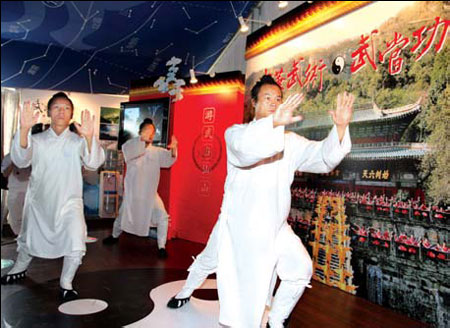China in a hut-shell
|
Taoists from the Wudang Mountains practice Wudang kungfu in the Hubei Hut. File photo |
Thirty white huts lay sprawled across the eastern corner of the Olympic Center district, each displaying a part of China's rich and diverse traditional culture.
The exhibition entitled China Stories aims to promote Chinese culture and heritage, including folk customs, dance, music and handicrafts from nearly all of the country's 30 provinces.
The huts, referred to as xiangyun (auspicious cloud), are divided into different sections that represent China's provinces and autonomous regions. China Daily brings you another look inside some of the various xiangyun huts.
Hubei Hut
Yu Ronghua demonstrates the basic steps of Chinese kungfu inside.
Yu is a 15th generation heir of Wudang tai chi, one of the ancient kungfu martial art forms that was born in the Taoist Wudang Mountains of Hubei province. Zhang Sanfeng drew inspiration for the practice after watching a fight between a snake and magpie.
"A saying goes that the snake's wriggling motion against the direct attack from the magpie enlightened Zhang to create a set of motions and steps containing the balance between yin and yang," Yu says.
He steps back and delivers a blow, explaining the movement is a type of internal kungfu. It illustrates a theory in which one absorbs the enemy's power by focusing on mental rather than physical strength.
With their long hair tied back up in knots on top of their heads, and dressed in long robes, the Taoist monks welcome visitors in to learn more about the esoteric martial art of the Wudang Mountains.
"I was always confused about (the difference between) kungfu from the Wudang and Shaolin monasteries," says David Culpan, a Chinese kungfu enthusiast.
"Now, my understanding is the former addresses the interior qi, and the latter focus on the external qi."
After visiting the hut, Culpan says he is anxious to visit the sacred Wudang Mountains, where scenes from Crouching Tiger, Hidden Dragon were filmed.
The hut also showcases spectacular photos of ancient buildings and the natural beauty of the mountains. Visitors can also partake in a traditional tea ceremony, which is led by Taoist tea masters. The first cup is offered to ancestors, the second to themselves and the third to guests.
(China Daily 08/23/2008 page15)















